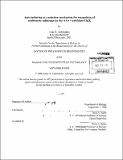| dc.contributor.advisor | Tania A. Baker. | en_US |
| dc.contributor.author | Abdelhakim, Aliaa H. (Aliaa Hamid) | en_US |
| dc.contributor.other | Massachusetts Institute of Technology. Department of Biology. | en_US |
| dc.date.accessioned | 2014-04-25T15:48:50Z | |
| dc.date.available | 2014-04-25T15:48:50Z | |
| dc.date.copyright | 2008 | en_US |
| dc.date.issued | 2008 | en_US |
| dc.identifier.uri | http://hdl.handle.net/1721.1/86282 | |
| dc.description | Thesis: Ph. D. in Biochemistry, Massachusetts Institute of Technology, Department of Biology, 2008. | en_US |
| dc.description | Cataloged from PDF version of thesis. | en_US |
| dc.description | Includes bibliographical references. | en_US |
| dc.description.abstract | The CIp/Hsp1OO enzymes, which belong to the AAA+ family of ATPases, use their unfoldase activity to degrade and remodel multimeric substrates in the bacterial cell. The mechanical energy exerted by CIp/Hsp1OO enzymes drives forward essential transitions in important biological processes. However, with a potentially destructive and energetically expensive enzymatic activity, mechanisms must be employed to ensure that Clp/Hsp1OO enzymes act on the desired substrate at the right time and in the right location. The remodeling of stable complexes by Clp/HsplOO enzymes must be directed toward the correctly assembled form of substrates in the cell, and therefore strategies must exist that guide Clp/Hsp1OO enzymes to correctly distinguish between multimeric and monomeric forms of a substrate. In this work I explore how substrate multimerization modulates recognition by the enzyme, using the AAA+ unfoldase CIpX and its multimeric substrate the Mu transpososome. Phage Mu transposase tetramerizes in the cell to form the Mu transpososome, which mediates replicative transposition of the phage. After transposition is completed, the Mu transpososome forms an extremely stable tetramer that needs to be destabilized by CIpX to allow it to facilitate phage Mu genome amplification. How CIpX is guided to the correctly assembled stable transpososome is the subject of my work. I find that multimerization of the phage Mu transposase to form the tetrameric Mu transpososome exposes residues that make contact with the CIpX only in the context of the tetrameric complex. These unique contacts recruit CIpX to the stable transpososome with high affinity. The dual role of subunits in the transpososome in providing high affinity CIpX binding sites as well as CIpX substrate degradation signals is referred to in this work as auto-tethering. Additionally, I show that the N terminal domain of CIpX, which plays a role in substrate selection, is important in facilitating discrimination between different multimeric forms of MuA by CIpX. CIpX destabilizes the tetrameric transpososome by unfolding only one of the subunits within the complex. However, it is not known which subunit within the transpososome is unfolded, nor is it clear whether it is the same or different subunits that facilitate high affinity binding of CIpX to the complex. I am currently performing experiments to determine the geometry of unfolding and auto-tethering using an altered specificity mutant of MuA, which binds to Mu DNA binding sites in the transpososome containing compensatory mutations. This work can shed light on the division of labor required to mediate auto-tethering in the transpososome as well as in other multimeric substrates of CIpX. | en_US |
| dc.description.statementofresponsibility | by Aliaa H. Abdelhakim. | en_US |
| dc.format.extent | [145] pages in various pagings | en_US |
| dc.language.iso | eng | en_US |
| dc.publisher | Massachusetts Institute of Technology | en_US |
| dc.rights | M.I.T. theses are protected by copyright. They may be viewed from this source for any purpose, but reproduction or distribution in any format is prohibited without written permission. See provided URL for inquiries about permission. | en_US |
| dc.rights.uri | http://dspace.mit.edu/handle/1721.1/7582 | en_US |
| dc.subject | Biology. | en_US |
| dc.title | Auto-tethering as a selection mechanism for recognition of multimeric substrates by the AAA+ unfoldase ClpX | en_US |
| dc.type | Thesis | en_US |
| dc.description.degree | Ph. D. in Biochemistry | en_US |
| dc.contributor.department | Massachusetts Institute of Technology. Department of Biology | |
| dc.identifier.oclc | 874754995 | en_US |
